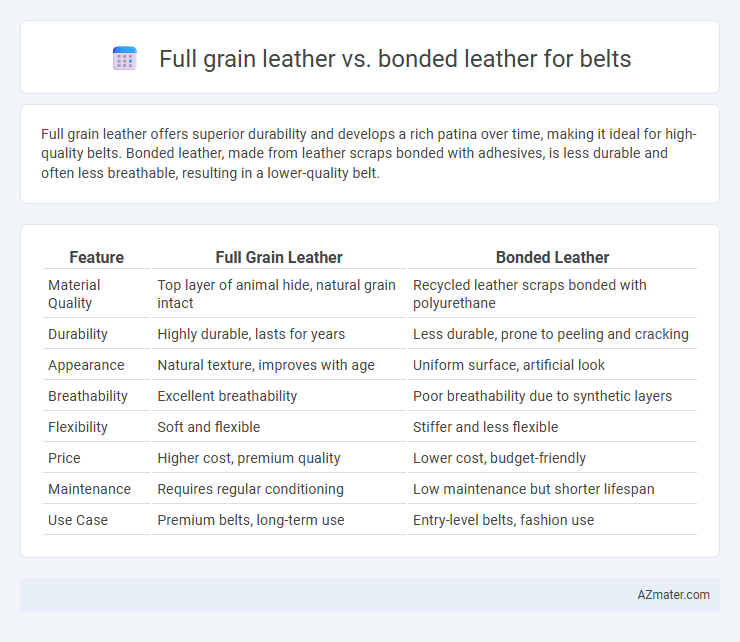Full grain leather offers superior durability and develops a rich patina over time, making it ideal for high-quality belts. Bonded leather, made from leather scraps bonded with adhesives, is less durable and often less breathable, resulting in a lower-quality belt.
Table of Comparison
| Feature | Full Grain Leather | Bonded Leather |
|---|---|---|
| Material Quality | Top layer of animal hide, natural grain intact | Recycled leather scraps bonded with polyurethane |
| Durability | Highly durable, lasts for years | Less durable, prone to peeling and cracking |
| Appearance | Natural texture, improves with age | Uniform surface, artificial look |
| Breathability | Excellent breathability | Poor breathability due to synthetic layers |
| Flexibility | Soft and flexible | Stiffer and less flexible |
| Price | Higher cost, premium quality | Lower cost, budget-friendly |
| Maintenance | Requires regular conditioning | Low maintenance but shorter lifespan |
| Use Case | Premium belts, long-term use | Entry-level belts, fashion use |
Introduction: Understanding Full Grain vs Bonded Leather
Full grain leather, derived from the top layer of hide, offers unmatched durability, natural texture, and aging quality, making it ideal for premium belts. Bonded leather consists of leather scraps bonded with polyurethane or latex, resulting in a more affordable but less durable alternative lacking the unique grain of genuine leather. Understanding these fundamental differences helps consumers choose belts based on longevity, appearance, and budget preferences.
What is Full Grain Leather?
Full grain leather is the highest quality leather made from the top layer of the animal hide, retaining its natural grain and durability. It develops a rich patina over time, enhancing its strength and aesthetic appeal, making it ideal for premium belts. Unlike bonded leather, which is made from leather scraps bonded with adhesives, full grain leather offers superior breathability and longevity.
What is Bonded Leather?
Bonded leather is made by combining shredded leather fibers with a polyurethane or latex backing to create a material that mimics genuine leather's appearance at a lower cost. Unlike full grain leather, which uses the entire leather hide retaining natural texture and durability, bonded leather lacks the strength and aging qualities due to its synthetic composition. For belts, bonded leather offers an affordable option but typically wears out faster and is less breathable compared to the premium quality and longevity found in full grain leather belts.
Durability: Full Grain Leather vs Bonded Leather
Full grain leather offers superior durability for belts due to its dense, natural fiber structure that resists stretching and tearing over time. Bonded leather, made by combining leather scraps with adhesives, lacks the strength and longevity of full grain leather, often showing wear and peeling within months. Choosing full grain leather ensures a belt that maintains its integrity and appearance through years of daily use.
Appearance and Texture Differences
Full grain leather belts showcase a natural, rich texture with visible grain patterns and unique markings, offering a smooth yet rugged feel that improves with age. Bonded leather belts, made from shredded leather fibers blended with adhesives, present a uniform surface that often lacks the depth and character seen in full grain leather, resulting in a smoother but less durable texture. The appearance of full grain leather is more authentic and luxurious, while bonded leather tends to have an artificial finish that can peel or crack over time.
Cost Comparison: Full Grain vs Bonded Leather Belts
Full grain leather belts typically cost between $50 to $150 due to their durability, natural texture, and premium tanning process, whereas bonded leather belts range from $10 to $40, reflecting the use of leather scraps bonded with adhesives. The higher price of full grain leather results from its superior strength and aging characteristics, making it a long-term investment. Bonded leather belts provide a budget-friendly option but lack the longevity and authentic look found in full grain leather.
Long-Term Wear and Aging
Full grain leather belts exhibit superior long-term wear and aging properties due to their dense fiber structure and natural oils, which develop a rich patina over time. Bonded leather, made from shredded leather pieces bonded with polyurethane or latex, tends to degrade faster, peeling and cracking with extended use. Investing in full grain leather ensures durability, breathability, and an attractive aged appearance that enhances with age, unlike the synthetic finish of bonded leather belts.
Environmental Impact and Sustainability
Full grain leather, derived from the top layer of hide, offers superior durability and ages naturally, reducing the need for frequent replacements and minimizing waste. Bonded leather, made from leather scraps bonded with adhesives, often contains synthetic materials that hinder biodegradability and contribute to environmental pollution. Choosing full grain leather belts promotes sustainable consumption through longevity and reduced chemical processing compared to the resource-intensive and less eco-friendly production of bonded leather.
Ideal Uses for Each Type of Leather Belt
Full grain leather belts offer exceptional durability, making them ideal for everyday wear and heavy use, such as work or casual belts that require long-lasting strength and natural aging characteristics. Bonded leather belts are better suited for fashion-focused, budget-friendly options where appearance matters more than longevity, typically used for occasional wear or accessory belts. Choosing full grain leather supports robust functionality and timeless style, while bonded leather caters to style flexibility and affordability in low-impact use scenarios.
Conclusion: Choosing the Best Leather for Your Belt
Full grain leather offers unparalleled durability, natural texture, and ages beautifully, making it the best choice for a high-quality belt that lasts and improves over time. Bonded leather, made from scraps and fibers bonded together, is more affordable but lacks the strength, breathability, and longevity of full grain leather. For a belt investment that combines style, comfort, and durability, full grain leather remains the superior option.

Infographic: Full grain leather vs Bonded leather for Belt
 azmater.com
azmater.com